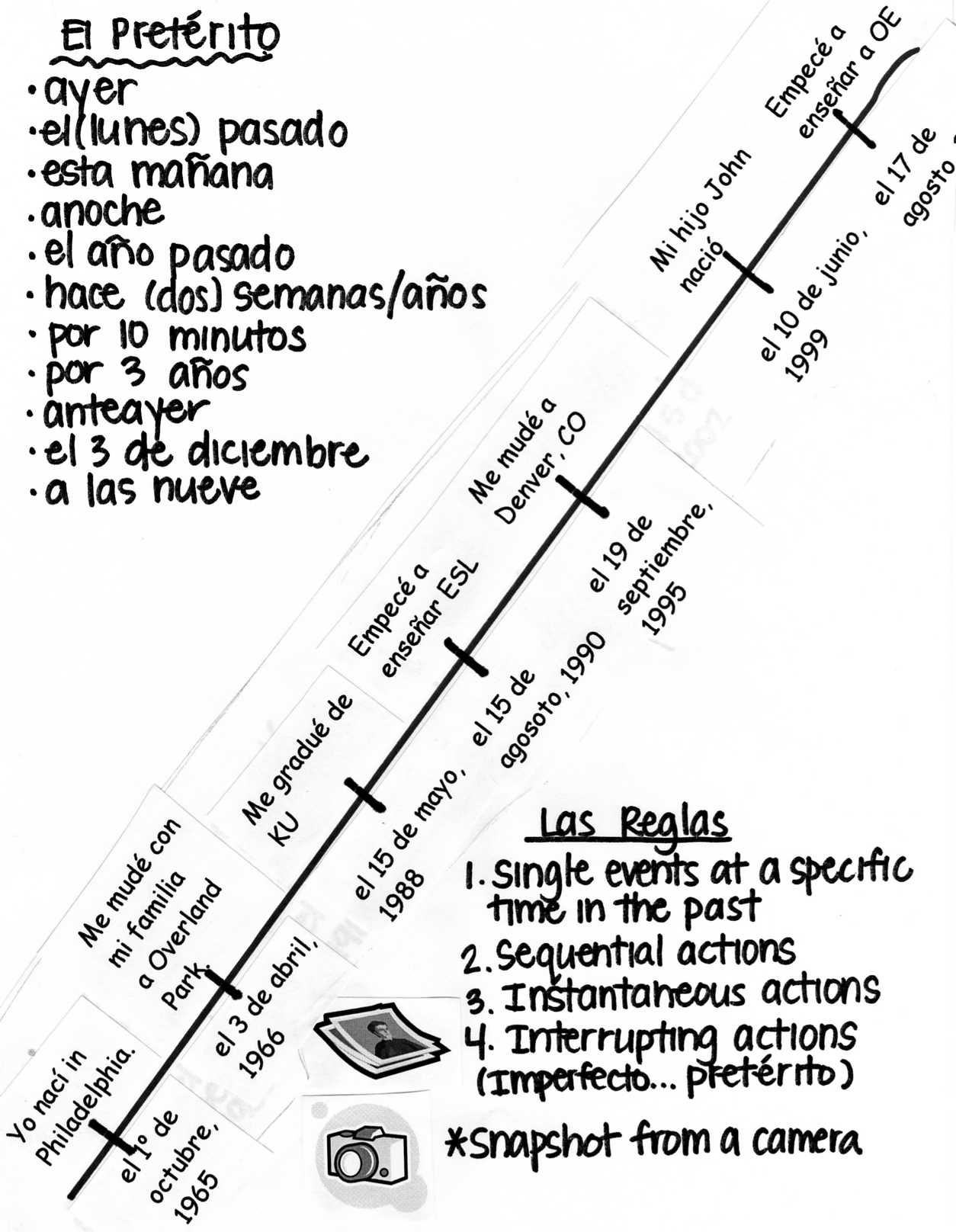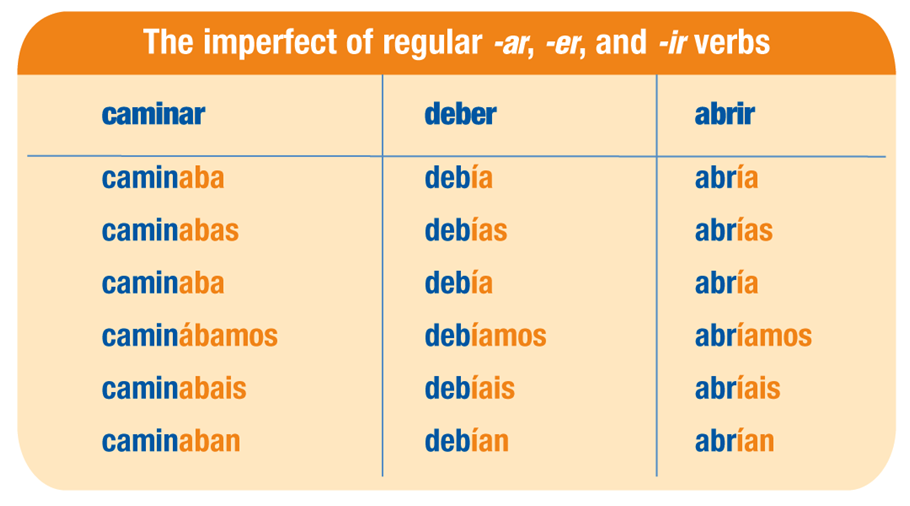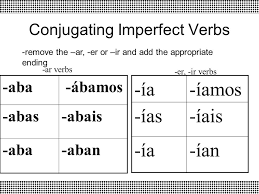In this video presentation you will learn the general rules for conjugating regular Spanish verbs in the:
- Pretérito Imperfecto (Imperfect) tense
- Indicativo mood
Note the timeline
The ability to properly locate the desired position on the timeline is a crucial skill for proper use of tenses. So pay attention to the timeline in our lessons and visualize it while speaking, listening, writing and reading. After some practice you’ll be able to select the right tense to use much easier.

How to create and use the Imperfect tense in Spanish
The Imperfect tense is one of the easiest Spanish tenses, because:
- There are only three verbs that conjugate irregularly
- The -er and -ir verb groups use the exact same endings as the Conditional tense
- The 1st & 3rd person singular (yo & él/ella/usted) have identical forms
The full name of this tense, which you may sometimes encounter, is Pretérito Imperfecto de Indicativo. Let’s have a look at its conjugation, usage and examples.
Regular verb conjugation in Spanish Imperfect tense
Pretérito Imperfecto belongs to the simple tenses group, which means that all of its inflected forms are one word long. There are also compound (compuesto) tenses in Spanish language, where each conjugated form consists of two words.
The basis for the conjugation in this tense is the stem of the verb, so we need to start by splitting the infinitive into a stem and an ending. It’s really easy to do. Simply remove two letters from the end of the infinitive to get the ending — one of -ar, -er or -ir. What’s left is the stem.
For example, if we take the verb viajar and cut off the last two letters, we will get:
- the stem: viaj-
- and the ending: -ar
Next, to the stem of the infinitive we add an ending specific to a particular grammatical person to create this person’s form. Continuing our example, if we wanted to create the form for the 1st person singular (yo) of the verb viajar, we would add to the stem viaj- the ending -aba to get viajaba.
The endings used in Pretérito Imperfecto de Indicativo
The two images below present the endings used in Pretérito Imperfecto. Note the shapes and colors of the letters. Find the similarities and differences between the sets. It should help you find patterns and make it easier to remember them. For instance, notice that:
- The 1st & 3rd person singular (yo & él/ella/usted) have the same endings in each verb group and always end with the letter a
- The 2nd person singular (tú) always ends with the letters as
- The 1st person plural (nosotros/nosotras) always ends with the letters amos
- The 2nd person plural (vosotros/vosotras) always ends with the letters ais.
- The 3rd person plural (ellos/ellas/ustedes) always ends with the letters an.

These endings are for the -ar verb group. And that’s an example of recordar conjugation:
| singular | plural | ||
|---|---|---|---|
| yo | recordaba | nosotros/nosotras | recordábamos |
| tú | recordabas | vosotros/vosotras | recordabais |
| él/ella/usted | recordaba | ellos/ellas/ustedes | recordaban |

And this set of endings is used by both the -er and -ir verb groups – they are identical in both groups.
The example conjugation for the verb volver (-er conjugation group) would be:
| singular | plural | ||
|---|---|---|---|
| yo | volvía | nosotros/nosotras | volvíamos |
| tú | volvías | vosotros/vosotras | volvíais |
| él/ella/usted | volvía | ellos/ellas/ustedes | volvían |
Another example is for the verb recibir (-ir conjugation group):
| singular | plural | ||
|---|---|---|---|
| yo | recibía | nosotros/nosotras | recibíamos |
| tú | recibías | vosotros/vosotras | recibíais |
| él/ella/usted | recibía | ellos/ellas/ustedes | recibían |
Spend some time looking for more patterns, then try writing all the endings down just from your memory.
Irregular verbs in the Pretérito Imperfecto tense
There are only 3 irregular verbs in this tense. The easiest way to memorize them is to add them to the word basket (can be found in the Exercise section) and practice!
| Irregular verb #1 – ser: |
|
||||||||||||||||
| Irregular verb #2 – ir: |
|
||||||||||||||||
| Irregular verb #3 – ver: |
|
||||||||||||||||
When do we use the Imperfect tense in Spanish
The Imperfect tense is used in Spanish in several ways:
-
Talking about a past action as being in progress without specifying when it began or ended
In English, the Past Progressive tense is used in those cases.
Ella leía el periódico en una pequeña cafetería en la esquina.She was reading the newspaper in a little cafe on the corner.El Domingo hacía un día precioso: el sol brillaba y el cielo era azul.There was a beautiful day on Sunday: the sun was shining and the sky was blue.Estaba en el concierto, y allí encontré a un antiguo amigo.I was in the concert and there I met my old friend.Carlitos estaba mirando una película de terror cuando escuchó el sonido raro.Carlitos was watching a horror movie when he heard a weird noise.Estaba en el baño cuando sonó mi teléfono.I was in the bathroom when my telephone rang. -
Describing what used to happen or what happened regularly/periodically in the past
Cuando era joven, íbamos al cine todos los domingos.When I was young, we used to go to the cinema every Sunday.Sonia iba mucho a la playa cuando era pequeña.Sonia used to go a lot to the beach when she was little.Cuando vivía en España tocaba la guitarra todos los días.When I was living in Spain I used to play guitar all day long.Antes Oscar jugaba con sus amigos pero ahora juega con el ordenador.Oscar used to play with his friends, but now he plays computer.Cuando era niña, comía mucho más que ahora.When I was a little girl I used to eat much more than now. -
Describing mental (think, want, expect), physical (hungry, thirsty, cold, warm) and emotional (love, hate) state in the past without indicating the change of it
Tenía mucho sed.I was very thirsty.Estábamos muy cansados porque andábamos por toda la noche.We were (feeling) very tired because we were walking all night.Mi madre tenía miedo de perros, pero ahora está bien.My mother was afraid of dogs, but now she is ok.Estudiábamos mucho y esperábamos una buena nota en el examen.We were studying a lot and we were expecting good grades.Ángel pensaba que Felisa era muy inteligente.Ángel thought that Felisa was very intelligent.¡Qué frío tenía en Patagonia!I was very cold in Patagonia! -
Using ser/estar in a description without referring to any time limits
Su hermano menor era más alto que ella.Her little brother was taller than her.El auto de mis padres era muy cómodo.My parent’s car was really comfortable.Estábamos en America del Sur el año pasado.We were in South America last year. -
When indicating an ongoing action and for how long it was going on
In construction: hacía + time expression + que + Imperfecto
Hacía tres años que viajaba.I had been traveling for three years.Hacía dos horas que trabajaba.I had been working for two hours.
In construction: Imperfecto + desde hacía + time expressionViajaba desde hacía tres años.I had been traveling for three years.
In construction: llevar + time expression + Gerund (llevar is likewise used in the Imperfect)Llevaba tres años viajando.I had been traveling for three years.
Time expressions used in Spanish Imperfect tense
The following time expressions are often used with Pretérito Imperfecto de Indicativo:
| time expression | meaning |
|---|---|
| todos los días | every day |
| como siempre | as always |
| a veces | sometimes |
| de vez en cuando | once in a while |
| muchas veces | many times |
| por un rato | for a while |
| siempre | always |
| tantas veces | so many times |
| generalmente | generally |
| frecuentemente | frequently |
| todo el tiempo | all the time |
| cada miércoles | every Wednesday |
Report a mistake | Give feedback
We strive to provide the highest quality content and we greatly appreciate even the smallest suggestions:

